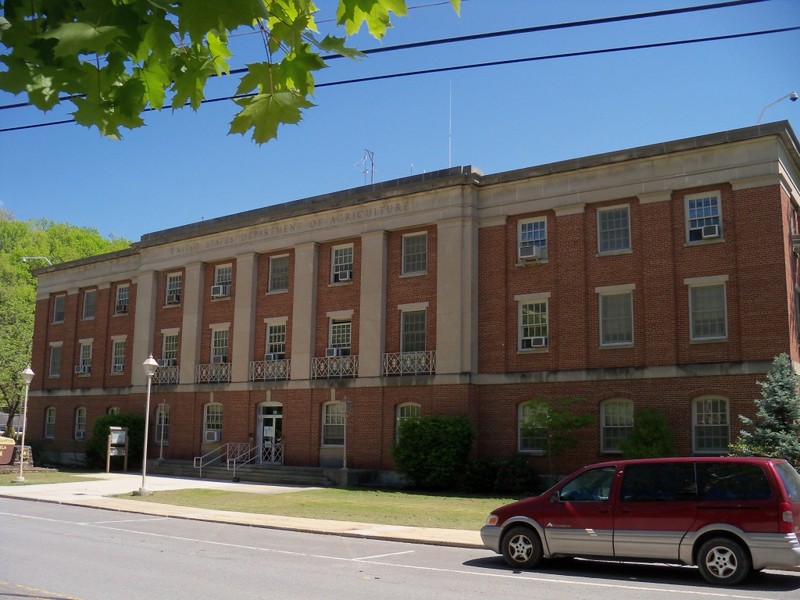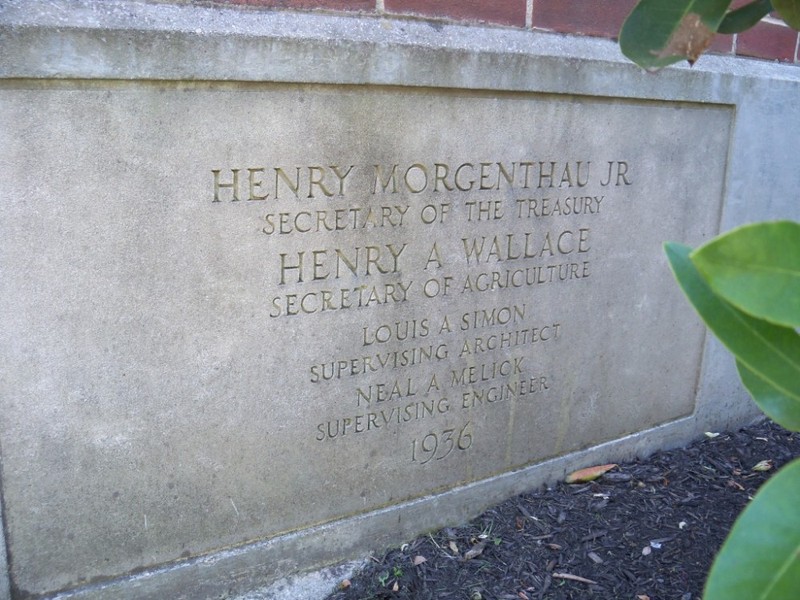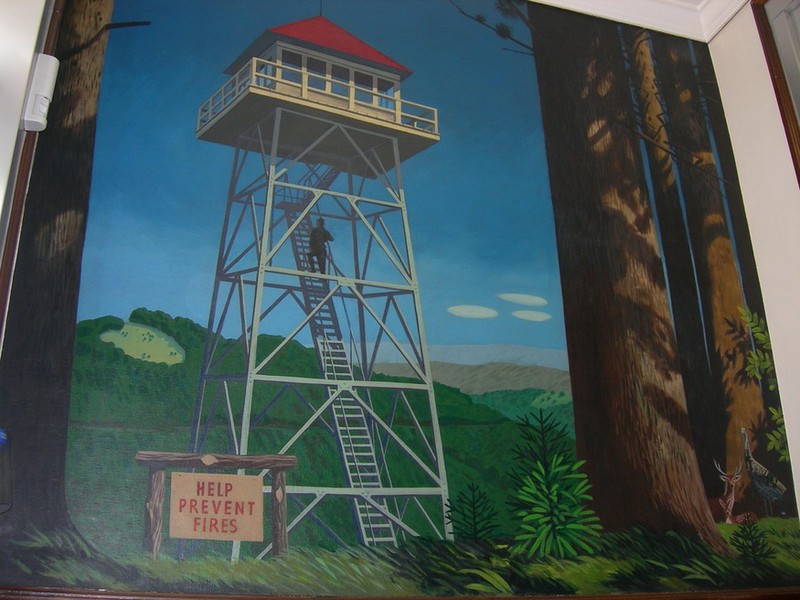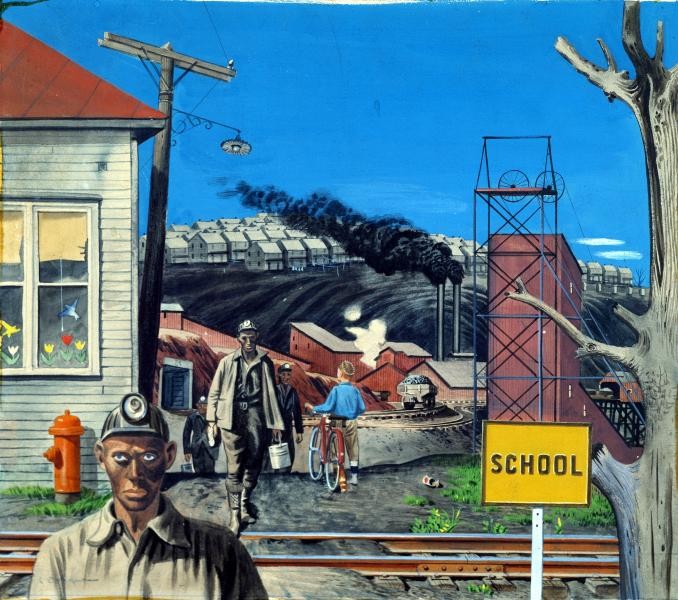United States Forest Service Building & New Deal Murals
Introduction
Text-to-speech Audio
The United States Forest Service Building in Elkins, West Virginia was built between 1936 and 1938 as a Works Progress Administration project. The Neo-Classical Revival building is typical of public buildings from this time period and remains in use today. Significant in its own right, the structure is also unique in containing not one, but two New Deal murals. Both “Forest Service” and “Mining Village” were executed in tempera by Stevan Dohanos in 1939. The two works express quite different messages and their position across from each other in the lobby provokes reflective dialog on the contrast.
Images
The United States Forest Service Building.

Cornerstone of the building.

“Forestry Service.”

“Mining Village.”

Backstory and Context
Text-to-speech Audio
The United States Forest Service Building, also known as Monongahela National Forest Supervisor’s Headquarters, was constructed between 1936 and 1938. The building was an early initiative of the Works Progress Administration (WPA). Louis A. Simon designed the Neo-Classical Revival style structure to house various aspects of the Department of Agriculture and the Forest Service. Civilian Conservation Corps and New Deal administration were also contained in the building. The building is a three-story rectangular structure built primarily with red brick. The central entrance portico has five main bays with three additional bays on each side. Wrought iron balconies, a stone cornice, and carved lettering reading “United States Department of Agriculture” provide some softening ornamentation to the otherwise spartan facade. In addition to the building itself, the grounds were landscaped by the Civilian Conservation Corps.
Two New Deal murals can be found in the building. The first, “Forest Service,” features a view of a fire watch tower on a ridgeline. A single figure climbs the ladder into the structure while a sign at the base sends a clear message: “HELP PREVENT FIRES.” Just barely visible on the right of the composition are a buck and a large bird. Despite the caution against fire, the landscape is peaceful and undisturbed. Several hallmarks of New Deal art — clean lines, bright colors, and a moralizing message — establish the piece firmly in the style of public art at the time. Despite these features, the figure in the image is reduced to an anonymous silhouette, which simultaneously reinforces the responsibility of individuals and honors the work of the Forestry Service.
Across from “Forest Service” is “Mining Village.” The latter mural provides a sharp contrast to the anonymous and tranquil nature of the former. “Mining Village” is primarily realistic in style with some concessions made for practical perspective reasons. Rows of identical employee houses occupy the background and are separated from the foreground by rails, a mine portal, coal tipple, and the buildings involved in economic pursuits. In the foreground is a school identified with a yellow sign and sporting brightly colored window decorations. A set of railroad tracks run parallel to the building. On the right side of the image is a dead tree. Five figures are positioned near the tracks. Four Black miners move towards the viewer while a young white boy with a bike faces away. The closest figure stares intensely out of the mural with a grim expression. The eye contact is piercing and accusatory, but also somehow as if he sees through the viewer. Despite the apparent bright light washing the scene, the eyes of the next closest miner are Black pits. The realistic style of painting makes the disparity between the two miners all the more jarring. In fact, the piece was originally intended for a Works Progress Administration post office in Huntington, West Virginia. The post office refused the piece after local residents deemed it too depressing and it was installed at the Forest Supervisor’s Headquarters instead.
Stevan Dohanos was one of the most prolific New Deal artists. A native of Ohio, Dohanos attended the Cleveland SChool of Art before finishing his matriculation at the George Pearce Ennis School in Eastport, Maine. As a New Deal artist, Dohanos decorated post offices and other public buildings in Florida, the Virgin Islands, and the northeast. Dohanos eventually found himself in New York City, where he made a name creating Saturday Evening Post covers and New Yorker cartoons. He also designed numerous stamps for the United States Postal Service and the Postal Service’s Hall of Stamps in Washington D.C. was dedicated in Dohanos’ honor.
Sources
50 Year History of the Monongahela National Forest. United States Department of Agriculture, 1970.
Emerson, Jimmy. Forestry Service, New Deal Art Registry. Accessed June 22nd 2021. https://newdealartregistry.org/map/Elkins/WV/#.
Mining Village (Study for mural, Huntington, West Virginia forestry service building), Smithsonian American Art Museum. Accessed June 22nd 2021. https://americanart.si.edu/artwork/mining-village-study-mural-huntington-west-virginia-forestry-service-building-35915.
Monongahela National Forest: Forest Supervisor's Headquarters Murals - Elkins WV, The Living New Deal. Accessed June 22nd 2021. https://livingnewdeal.org/projects/mnf-forest-supervisors-headquarters-murals-elkins-wv/.
Park, Marlene. Markowitz, Gerald E. Democratic Vistas: Post Offices and Public Art in the New Deal. Philadelphia, Pennsylvania. Temple University Press, 1984.
Raynor, Patricia. Off the Wall, National Postal Museum. October 1st 1997. Accessed June 22nd 2021. https://postalmuseum.si.edu/resources/6a2q_postalmurals.html.
Stevan Dehanos, The Cleveland Museum of Art. Accessed June 22nd 2021. https://www.clevelandart.org/art/1934.69.
Stevan Dehanos, National Museum of American Illustration. Accessed June 22nd 2021. http://www.americanillustration.org/artists/dohanos/dohanos.html.
Taylor, David L. Wees Historic District, National Register of Historic Places. October 1st 2005. Accessed June 22nd 2021. https://npgallery.nps.gov/GetAsset/3a51f2eb-d252-415e-b52f-69aafd3e0bdb.
This Week in History, United States Department of Agriculture Forest Service. Accessed June 22nd 2021. https://www.fs.usda.gov/detail/mnf/learning/history-culture/?cid=FSEPRD690566.
U.S. Forest Service Building, Elkins, WV, U.S. General Services Administration. Accessed June 22nd 2021. https://www.gsa.gov/historic-buildings/us-forest-service-building-elkins-wv#significance.
The Living New Deal. Accessed June 22nd, 2021. https://livingnewdeal.org/projects/mnf-forest-supervisors-headquarters-elkins-wv/.
The Living New Deal. Accessed June 22nd, 2021. https://livingnewdeal.org/projects/mnf-forest-supervisors-headquarters-elkins-wv/.
Emerson, Jimmy. New Deal Art Registry. Accessed June 22nd, 2021. https://newdealartregistry.org/map/Elkins/WV/#.
Smithsonian American Art Museum. Accessed June 22nd, 2021. https://americanart.si.edu/artwork/mining-village-study-mural-huntington-west-virginia-forestry-service-building-35915
